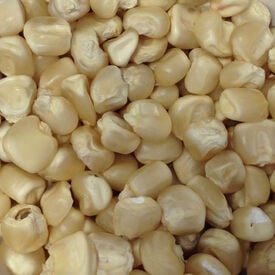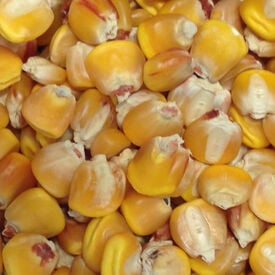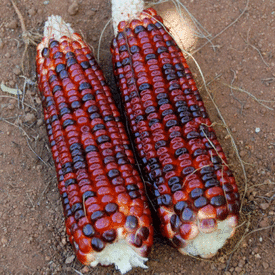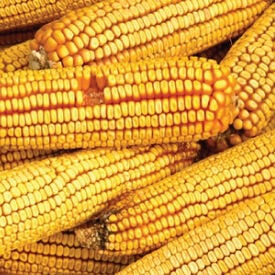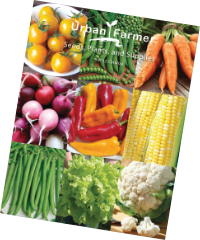Krug Dent corn is an old commercial variety. First bred by Illinois farmer George Krug in 1921. George W. Krug started experimenting with corn in 1906 to develop a corn that would be more productive for his 100 acre estate. George started his seed line by mixing two strains called Improved World's Fair and Iowa Gold Mine with a couple of bushels of good-looking seed which he purchased at a farm sale. The qualities he selected for included weight, luster, smoothness, freedom of excessive starch and high oil content. He entered his corn in the county farm bureau yield test in 1919, and topped the field in 1920 and 1921 among 118 growers who entered these tests. Hereafter Krug Dent became famous and was sought after everywhere. George Krug however was a very modest man and did not collect a royalty from any of those using his name in producing "Krug Corn." all he wanted was a better corn for his farm.
Minnesota 13 corn seed is a hybrid variety specifically developed to thrive in the northern climates and shorter growing seasons of regions like Minnesota. This dent corn is renowned for its adaptability and resilience, featuring strong stalks that can withstand harsh weather conditions. With a relatively short maturity period, it offers good yield potential, making it a reliable choice for farmers looking to maximize production. Additionally, Minnesota 13 is bred for resistance to common pests and diseases, ensuring robust growth and high-quality grain. Its versatility allows it to perform well in various soil types, particularly in well-drained, fertile soils, making it a staple in northern Midwest agriculture.
Green Field corn produces an abundance of tall (8-10') stalks with 8-9" long ears. Developed from Reid's Yellow Dent, this corn produces bright yellow, long and narrow 14-kernel row ears. Green Field was the name of the farm that this corn was first produced on. Reported yields of 190 bu/acre in the boot heel area of MO.
Dublin corn produces beautiful tall stalks that can reach 8-10' with 8-9" long ears. Originating from Dublin, Ontario this corn was developed for a short growing season. A high protein percentage of 10-11%, this variety can be used for flour, cornmeal, and by distilleries.
Mosby White Prolific is an old and popular dent corn variety first developed in 1876 by J.K. Mosby of Mississippi. Produces strong and tall stalks often reaching 10-12' tall with 2-4 ears. Ears often reach 8-9" with creamy white kernels. By the early 1900s, most of the major Southern seed houses, as well as newspapers full of farmer's advertisements, were selling the seed. Although now fairly rare, 'Mosby Prolific' was once extensively grown for feed and silage; particularly in the South and Gulf States.
Hickory King White corn is a classic heirloom variety known for its large, white kernels and tall, sturdy plants. Native to the Appalachian region of the United States, this corn is prized for its versatility and excellent texture, making it ideal for grinding into cornmeal, grits, and flour, as well as for use in hominy. The kernels are particularly large and starchy, which makes them perfect for creating rich, hearty dishes. Hickory King White corn is also valued for its ability to grow in a variety of soil types and climates, thriving in both the cool Appalachian mountains and warmer regions. As an open-pollinated variety, it is a great choice for sustainable farming and seed-saving, helping to preserve a piece of agricultural history. This corn's adaptability, resilience, and rich flavor continue to make it a favorite among gardeners and farmers who appreciate traditional crops with a long-standing heritage.
Hickory King Yellow corn is a traditional heirloom variety renowned for its large, yellow kernels and excellent versatility in the kitchen. Originally from the Appalachian region, this corn is prized for its rich, starchy texture and high yield. It’s commonly used for making cornmeal, grits, and flour, as well as for hominy, and its large kernels make it perfect for grinding into fine or coarse products. Hickory King Yellow corn is also known for its tall, sturdy plants that are adaptable to a range of soil types and growing conditions, making it resilient in both cooler and warmer climates. As an open-pollinated variety, it is well-suited for sustainable farming and seed-saving, allowing farmers and gardeners to preserve this piece of agricultural heritage. With its adaptability, high yield, and diverse culinary applications, Hickory King Yellow corn remains a popular choice for those seeking a reliable, flavorful heirloom crop.
Argentina Orange Creole Flint corn seeds are a traditional, heirloom variety of corn originating from Argentina. Known for its distinctive orange kernels and high-quality, dense texture, this variety has been cultivated for centuries by local farmers. It is prized for its ability to adapt to a variety of growing conditions and its excellent resistance to pests and diseases. The corn is often used for making masa (corn dough) in traditional Argentine dishes, such as tamales and empanadas, and is also enjoyed for its rich flavor and vibrant color. As an open-pollinated variety, it is valued by sustainable farming communities and those focused on preserving genetic diversity in crops.
Bloody Butcher corn is a striking heirloom variety known for its deep red kernels and bold, rustic flavor. This ancient American corn is traditionally grown for both its ornamental beauty and its culinary versatility. The vibrant red and purple kernels make it an eye-catching addition to any garden, while the corn itself is prized for its dense, starchy texture, which is perfect for grinding into cornmeal, flour, and grits. Bloody Butcher corn is also commonly used in hominy and for popping. Its tall, robust plants are well-suited for a variety of growing conditions, thriving in warm climates with well-drained soil. As an open-pollinated variety, Bloody Butcher is excellent for sustainable farming and seed-saving, ensuring its continued presence in both historical and modern agriculture. This heirloom variety not only adds color and flavor to the kitchen but also carries a rich history, making it a favorite for gardeners and farmers alike.
Wapsie Valley heirloom corn is a traditional variety that hails from the Wapsipinicon River Valley in Iowa. Known for its rich history and unique flavor, this heirloom corn features tall, sturdy plants that produce large ears with colorful, often striped kernels ranging from yellow to blue and red. The kernels are prized for their taste and are typically used for making cornmeal, grits, and other culinary applications. Wapsie Valley corn is not just valued for its flavor; it also has good adaptability to different soil types and conditions, often thriving in diverse environments. As an heirloom variety, it is appreciated for its genetic diversity and resilience, making it a popular choice among organic and sustainable farmers. The corn is also sought after by home gardeners and those interested in preserving traditional agricultural practices. Overall, Wapsie Valley heirloom corn represents both a connection to agricultural heritage and a commitment to biodiversity.
Reid's Yellow Dent Field corn is a traditional American heirloom variety known for its high yield, excellent versatility, and resilience. Originally developed in the 19th century, this corn was once a staple in Midwestern farming due to its ability to thrive in a range of soil types and climates. The kernels are large, golden-yellow, and dented, which is characteristic of field corn varieties. Reid’s Yellow Dent is primarily grown for its use in animal feed, as well as for grinding into cornmeal, flour, and masa for making tortillas, cornbread, and other baked goods. It's also popular for producing hominy and grits, and historically, it played a significant role in the production of corn syrup and ethanol. What makes Reid's Yellow Dent particularly valuable is its resilience in the field, with a high tolerance for drought and disease. This heirloom variety is open-pollinated, making it an excellent choice for sustainable farming and seed-saving. It has a robust history in agricultural development and remains a beloved variety for both small-scale and commercial farmers looking to grow an adaptable, productive crop with a deep connection to agricultural traditions.
Cherokee White Eagle corn is a traditional heirloom variety cherished for its striking appearance and cultural significance. This variety features tall plants that produce long ears adorned with white, plump kernels, which can sometimes have a slight yellow or cream tint. Known for its excellent flavor, Cherokee White Eagle corn is often used in a variety of culinary applications, including grits, cornmeal, and even as fresh sweet corn. Its kernels are particularly valued for their sweetness and unique texture. This corn variety has deep roots in Native American agriculture, particularly among the Cherokee people, where it has been cultivated for generations. Its resilience to various growing conditions makes it a reliable choice for both home gardeners and small-scale farmers. Cherokee White Eagle corn not only serves as a staple food source but also plays an important role in cultural traditions and ceremonies. Its rich history and versatility in the kitchen make it a treasured heirloom variety among those who appreciate heritage crops.
Cacahuazintle corn is a traditional Mexican heirloom variety, celebrated for its large, white kernels and its distinctive, slightly nutty flavor. Native to the central highlands of Mexico, this corn is a key ingredient in the making of pozole, a hearty and aromatic soup that is a staple in Mexican cuisine. The kernels are unique in that they have a thick, starchy texture, making them ideal for hominy production, where they undergo a process of nixtamalization to unlock their full nutritional potential. Cacahuazintle corn is particularly valued for its high resilience and adaptability to various soil types, thriving in the dry, high-altitude conditions of Mexico's interior. Its open-pollinated nature makes it a great choice for sustainable farming and seed-saving. As a heritage crop, Cacahuazintle corn not only contributes to the rich flavors of Mexican food but also holds deep cultural significance, linking generations of farmers and cooks to their roots. Sourced from a farming community in Estado de México, Cacahuazintle is the star of pozole throughout Mexico.
Oaxacan Green corn is a traditional heirloom variety native to the Oaxaca region of Mexico, renowned for its unique flavor and striking appearance. The kernels are a vibrant green, often taking on a bluish tint, and have a firm texture. This variety is primarily used for making masa, the dough used in tortillas and tamales, and is celebrated for its slightly nutty, sweet flavor. Oaxacan Green corn is typically a flint corn, which means it has a hard outer layer, making it ideal for grinding into flour. It thrives in warm climates and is well-suited to diverse growing conditions, often cultivated using traditional agricultural methods. This corn variety not only contributes to the rich culinary heritage of Mexico but also plays a vital role in biodiversity, making it a prized choice for both farmers and food enthusiasts seeking to preserve unique and flavorful crops.
Ohio Blue Clarage corn is a historic heirloom variety known for its distinctive blue kernels and rich flavor. Originating from Ohio, this variety has been cultivated for generations and is celebrated for its adaptability and resilience in various growing conditions. The plants typically grow tall, producing medium-sized ears with strikingly beautiful blue kernels that can also exhibit hints of purple or white. The unique coloration comes from anthocyanins, which are beneficial compounds found in blue corn. This corn is often used for making cornmeal, tortillas, and other traditional dishes, prized for its sweet, nutty flavor. Ohio Blue Clarage corn is well-suited for home gardens and small-scale farms, where it can thrive with proper care. As an heirloom variety, it contributes to agricultural biodiversity and is cherished by those looking to preserve traditional crops and flavors. Its heritage and versatility make it a favorite among gardeners and chefs alike, reflecting a rich agricultural history.
Argentino Cateto Orange Dent Corn is a traditional variety originating from Argentina, known for its distinctive orange-hued kernels. This heirloom corn features a unique dented shape, characteristic of dent corn, which results from the moisture loss in the kernels as they mature. The vibrant color not only adds aesthetic appeal but also indicates a rich nutritional profile, making it a valuable addition to both gardens and kitchens. It thrives in warm climates and is well-suited to diverse growing conditions, often appreciated by farmers for its resilience and adaptability. Culinarily, Argentino Cateto Orange Dent Corn is prized for its sweet, rich flavor, making it ideal for producing masa, polenta, and a variety of traditional Argentine dishes. Beyond its use in cooking, it is also used for animal feed and in the production of cornmeal and grits. Its robust stalks can reach impressive heights, providing a striking presence in any agricultural setting. As interest in heirloom varieties continues to grow, Argentino Cateto Orange Dent Corn stands out not just for its culinary applications but also as a testament to agricultural heritage and biodiversity.
Kentucky Rainbow Dent Corn is a vibrant heirloom variety known for its strikingly colorful kernels. The kernels typically showcase a mix of hues, including yellow, orange, red, and purple, making it not only a staple for culinary uses but also an eye-catching addition to gardens. This corn is classified as a dent corn, which means the kernels have a distinctive dent on the crown as they mature. It's primarily used for making cornmeal, grits, and is often sought after for decorative purposes, especially in autumn displays. Kentucky Rainbow Dent Corn is well-adapted to the climate of the region, and its rich flavor profile makes it popular among local growers and chefs alike. The plant itself grows tall, usually reaching heights of about 12 to 14 feet, with sturdy stalks and large green leaves that contribute to its robust appearance. Overall, it’s a celebrated variety for both its aesthetic appeal and culinary versatility. History: Bred by Susana Lein of Salamander Springs Farm in Berea, KY. Originating from Daymon Morgan’s Kentucky Butcher, this dent corn was grown by generations of Daymon Morgan’s family in Leslie Co., eastern KY.





